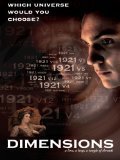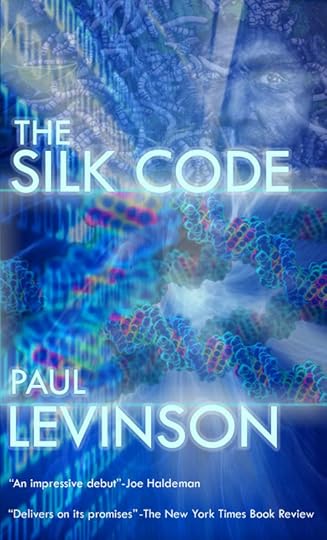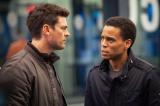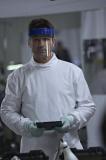Paul Levinson's Blog: Levinson at Large, page 321
February 12, 2014
Dimensions: Watercolor Time Travel
 With another winter storm howling on the doors of New York, I took refuge in Dimensions tonight, a lushly beautiful 2011 British time travel movie, recently made available on iTunes and Amazon Instant Video.
With another winter storm howling on the doors of New York, I took refuge in Dimensions tonight, a lushly beautiful 2011 British time travel movie, recently made available on iTunes and Amazon Instant Video.The director, Sloane U'Ren, has previous credits as a set designer in television shows ranging from Alias to Six Feet Under, and it shows in Dimensions. The movie, which tells a close-up story of a young scientist in 1920s England obsessed with time travel, moves like an Impressionistic painting from scene to scene, with images and textures and lenses that brush the soul.
There is a palpable innocence in the movie, which almost makes it akin to Primer, though Dimensions is barely about paradox and time loops. It is rather about love, sought and lost, accidental and deliberate. The movie also resonates with Daniel Faraday and Lost, which also has the charm of the young man as scientist -- though, again, Dimensions is manifestly not about the world-changing implications of the time travel we find in Lost.
The first part of the movie is indeed so uncontrived - a rarity for any time travel story - it almost seems like a YA or younger tale. As the movie progresses, we get a romantic triangle of characters in their twenties. The acting in this section is very good - the most memorable coming from Olivia Llewellyn and Camilla Rutherford's quietly powerful performances, and good work from Henry Lloyd-Hughes as the scientist, too - and this more than the storyline makes this part of the movie blossom. Antony Neely, whose main previous movie credits are in music, wrote the screenplay for Dimensions, and the story indeed progresses like a song, with versus and repeated chorus and bridge - an apt form for a time travel tale - or maybe an etude from Debussy.
Watercolors and tears, a story that moves like Donovan's "Wear Your Love Like Heaven," make Dimensions an unusual and even remarkable time travel story, which not only takes place in the 1920s but almost feels as if it was written and filmed back then, had such evocative color cinematography been available. See it if you'd like a compelling introduction to what time travel could be, or the sense of wonder you had when you encountered your first time travel story at 12 years of age.
~~~ +++ ~~~
Enjoy time travel stories? check out

"one of those extremely rare sequels that end up better than its predecessor ... worthy of the title, blockbuster, if this were a movie ... by far the best time travel story I've ever read" - Scott Sandridge, SpecMusicMuse

"resonates with the current political climate . . . . heroine Sierra Waters is sexy as hell . . . . there's a bite to Levinson's wit" - Brian Charles Clark, Curled Up With A Good Book
#SFWApro
Paul Levinson's books ... Paul Levinson's music
Published on February 12, 2014 22:11
February 11, 2014
Intelligence 1.6: Helix meets Rectify and Justified
 Intelligence 1.6 zoomed into Helix territory last night, with a sharp story that had Gabriel, Riley, and Cyber Command on what looks like a bio-terror virus-gone-wild case, but turns out to be our own military up to no good on behalf of what one general sees as a greater good for our country.
Intelligence 1.6 zoomed into Helix territory last night, with a sharp story that had Gabriel, Riley, and Cyber Command on what looks like a bio-terror virus-gone-wild case, but turns out to be our own military up to no good on behalf of what one general sees as a greater good for our country.But the best part of the plot is the puzzle of the set-up in which Patient Zero turns out to be someone we just saw getting the death sentence in Texas, so how can he be the vector of an epidemic which started after he was dead? Turns out our military spirited him away after injecting him with something not immediately lethal, to use him as a guinea pig for development of a vaccine for a possible terrorist attack via horrendous virus.
Some nice resonance in this twist on capital punishment to Rectify and last season's The Killing, and the contribution to viral fiction - writ large not only in Helix but of course The Walking Dead and even in National Geographic's Zombie Earth specu-docu-drama, where, believe it or not, I had a brief walk-on appearance as an "expert" - was good, too.
And speaking of welcome interconnections, it was great to see Nick Searcy as the wrong-minded General Carter, whose plan for the vaccine goes awry when the condemned prisoner escapes from the military lab, and becomes Patient Zero as he mixes into the crowd. It's been a good week for Searcy, who put in one of his best performances on Justify last week, as Chief Deputy U. S. Marshal Mullen makes like the inimitable Givens in a diner. (I'm glad I finally got a chance to mention Justified and Rectify in the same post.)
Back to Intelligence, we also find out more about how Gabriel came to be embedded with his chip, including that two previous candidates died and another wound up paralyzed in the process. He did it in the hope it would help him find Amelia, we learn again, but with her gone now, he admits to Riley that he thinks all the time about whether it was all worth it.
Intelligence is shaping up as one of the best new shows on television this season.
See also Intelligence Debuts ... Intelligence 1.2: Lightning Changes ...Intelligence 1.3: Edward Snowden and 24 ... Intelligence 1.4: Social Media Weaponry ... Intelligence 1.5: The Watch
#SFWApro

Like biological science fiction? Try The Silk Code
Paul Levinson's books ... Paul Levinson's music
Published on February 11, 2014 10:53
February 10, 2014
The Following 2.4: Psycho Families and Trains
 Family loomed large in The Following 2.4 tonight, in a whole bunch of intersecting ways.
Family loomed large in The Following 2.4 tonight, in a whole bunch of intersecting ways.Lily Gray, as we found out last week, is the mother of the twins, and she presides over a family that includes other psychos including Gillian - whose sheer love of killing makes her one of the most dangerous of the following we've encountered so far - and Emma, who deep down wants to be part of a family, including a mother's love, second only to her wanting Joe.
On the other side, we have Ryan and his niece Max, who, I've got to say and even though there's no need for comparisons, I'm beginning to like better than Lizzie in The Blacklist, because Max is more straightforward, not whiny and neurotic, and not marred to Lizzie's lamo husband. But, in any case, Ryan and Max make a great team, and her getting on train with Gillian was a great way to end the episode, with sounds of the train track echoing into the black tunnel and screen and Ryan's fears.
Meanwhile, there's yet another family connection - this one a mix of good guys and killers. I don't like the new FBI woman on this case at all - so far she's been an annoying, uncreative martinet - but the stunner that she and Jennifer share a family, including joint custody of kids, which Joe has just been embracing as he makes his way back to New York, was another reminder that we can take nothing for granted on this series.
This FBI-psycho connection, by the way, could cut both ways - to the detriment and death of Agent Martinez, or the same for Jennifer, or both. And, if Martinez gets the better of this, she could even get a pathway straight to Joe via Jennifer. Maybe Mandy, who's shaping up to be sagest killer of all, was right when she wondered if Joe would do well to kill Jennifer.
 Back to the train, and speaking of NYC, I also thought that the entire Grand Central Terminal chase and scene was great television, with a train mix that Alfred Hitchcock would have enjoyed. The Following this year has more cinematic power than ever, which, given its subject, makes it powerful indeed.
Back to the train, and speaking of NYC, I also thought that the entire Grand Central Terminal chase and scene was great television, with a train mix that Alfred Hitchcock would have enjoyed. The Following this year has more cinematic power than ever, which, given its subject, makes it powerful indeed.See also The Following Is Back for Its Second Season ... The Following 2.2: Rediscovering Oneself ... The Following 2.3: Coalescing
And see also The Following Begins ... The Following 1.2: Joe, Poe, and the Plan ... The Following 1.3: Bug in the Sun ... The Following 1.4: Off the Leash ... The Following 1.5: The Lawyer and the Swap ... The Following 1.7: At Large ...
#SFWApro

Paul Levinson's books ... Paul Levinson's music
Published on February 10, 2014 22:08
Almost Human 1.10: Killer Genes
 An excellent Almost Human 1.10 tonight, with two parallel stories - one episode specific, the other series wide - chocked full of science fictional detail, the usually good humorous touches, and having little to do with robotics.
An excellent Almost Human 1.10 tonight, with two parallel stories - one episode specific, the other series wide - chocked full of science fictional detail, the usually good humorous touches, and having little to do with robotics.Among the best futuristic touches, we have "chem printers" - a take-off from today's 3-D printers, except the chem printers create drugs not tangible technologies - and a nice post-it note effect, which I don't recall seeing used to such an extent on this show before, in which digital notes tossed across the room adhere to screens. And there's also a Mendel Institute, where designer genes are implemented in humans, and a reference to "McGregor" (I assume that's the way it's spelled), in the same breath as Einstein, meaning that this McGregor is a scientist of the same iconic importance as Einstein, who hasn't yet made the earth-shaking contribution as of February 2014.
Best humor is a sequence in which Kennex's driving under the influence (of drugs) causes his car to crash with Dorian in the passenger seat, which results in Dorian's ear being clipped, and some funny repartee to follow. I know, but I always liked The Three Stooges.
The stories are also good. "Cromes" are humans with genetically designed genes and improved intelligence, looks, etc. We already knew that Valerie is one of these, and tonight's episode focuses on the deaths which turn out to be murders of two young cromic women. A nice whodunit, with a somewhat surprising culprit, and one who refreshingly for this series has nothing to do with some high-tech syndicate or villain bent on ruling the world.
 The series-wide story is about as important as it gets, as Kennex begins to have memories of what almost got him killed and apparently got him betrayed by the woman he loved. We still don't know much about this, but his returning memories, even though drug induced, are a step in the right direction for the plot, as is the revelation at the end that he's being bugged. Presumably it's not the NSA, but you never know.
The series-wide story is about as important as it gets, as Kennex begins to have memories of what almost got him killed and apparently got him betrayed by the woman he loved. We still don't know much about this, but his returning memories, even though drug induced, are a step in the right direction for the plot, as is the revelation at the end that he's being bugged. Presumably it's not the NSA, but you never know.Looking forward to more next week.
See also: Almost Human debuts: A Review ... Almost Human 1.2: Sexbots ... Almost Human 1.3: Change of Face ... Almost Human 1.4: Almost Breaking Bad ... Almost Human 1.5: Clones and Holograms ...Almost Human 1.6: The Blackmarket Heart and Double Dorian ... Almost Human 1.7: Meets Criminal Minds ... Almost Human 1.8: Guided Bullets ... Almost Human 1.9: Literally Bad Robot
#SFWApro

Like science fiction about genetic engineering? Try The Silk Code
Paul Levinson's books ... Paul Levinson's music
Published on February 10, 2014 20:11
February 9, 2014
The Walking Dead 4.9: A Nightmare on Walking Dead Street
 A really different but no less harrowing - in some ways, more so - return of The Walking Dead in 4.9 tonight, in which we're treated to one nightmare for sure, and another which only becomes clear is not a nightmare near the very end.
A really different but no less harrowing - in some ways, more so - return of The Walking Dead in 4.9 tonight, in which we're treated to one nightmare for sure, and another which only becomes clear is not a nightmare near the very end.The almost nightmare is Carl's, and Chandler Riggs gives his best performance in this role tonight in the entire series so far. Angry at Rick for what happened and didn't happen at the end of the prison story in 4.8 last year - but just a few minutes in the past as 4.9 begins - Carl at first pulls away from his father, thinking and even wishing him dead in an Oedipal story come to fruition in The Walking Dead. He nearly gets killed by walkers a bunch of times as he walks to his presumed destiny, and when he wakes up in the house with Rick it seems highly likely that his briefly epic journey was just an horrific and instructive nightmare.
 It's only when Michonne makes her own way to the house, after a real journey and real nightmare of her own, that we learn for sure that what Carl experienced was not a dream at all. Michonne finds the note that one of the walkers when alive as a human left and Carl found, and she then find the can of pudding which we saw Carl eat - like Tom Sawyer sitting on the roof - and Carl told Rick about. And right before our eyes, in what passes for a happy ending in this series, Carl has grown up yet another notch, as has Rick, as he correctly recognizes that Carl has become a man. For Michonne this is also a happy ending at least for now, as the three reunited give her just a little more reason to live than she had wandering with walkers in tow to who knows what end.
It's only when Michonne makes her own way to the house, after a real journey and real nightmare of her own, that we learn for sure that what Carl experienced was not a dream at all. Michonne finds the note that one of the walkers when alive as a human left and Carl found, and she then find the can of pudding which we saw Carl eat - like Tom Sawyer sitting on the roof - and Carl told Rick about. And right before our eyes, in what passes for a happy ending in this series, Carl has grown up yet another notch, as has Rick, as he correctly recognizes that Carl has become a man. For Michonne this is also a happy ending at least for now, as the three reunited give her just a little more reason to live than she had wandering with walkers in tow to who knows what end.I liked this episode a lot, in part because it was the perfect breath to take after the carnage at the prison, and in part because it offered a fine tableau of the razor thin boundary between dream and reality in this compellingly insane world. It will be good - well, maybe not good but worthwhile - to find out what happens to the rest of our heroes in episodes to come this year.
See also The Walking Dead 4.1: The New Plague ... The Walking Dead 4.2: The Baby and the Flu ... The Walking Dead 4.3: Death in Every Corner ...The Walking Dead 4.4: Hershel, Carl, and Maggie ... The Walking Dead 4.6: The Good Governor ... The Walking Dead 4.7: The Governor's Other Foot ... The Walking Dead 4.8: Vintage Fall Finale
And see also The Walking Dead 3.3 meets Meadowlands ... The Walking Dead 3.4: Going to the Limit ... The Walking Dead 3.9: Making Crazy Sense ... The Walking Dead 3.10: Reinforcements ... The Walking Dead 3.11: The Patch ... The Walking Dead 3.12: The Lesson of Morgan ... The Walking Dead 3.13: The Deal ... The Walking Dead 3.14: Inescapable Parable ... The Walking Dead 3.15: Merle ... The Walking Dead 3.16: Kill or Die, or Die and Kill
And see also The Walking Dead Back on AMC ... The Walking Dead 2.2: The Nature of Vet ... The Walking Dead 2.3: Shane and Otis ... The Walking Dead 2.4: What Happened at the Pharmacy ... The Walking Dead 2.6: Secrets Told ... The Walking Dead 2.7: Rick's Way vs. Shane's Way ... The Walking Dead 2.8: The Farm, the Road, and the Town ... The Walking Dead 2.9: Worse than Walkers ... The Walking Dead 2.11: Young Calling the Shots ... The Walking Dead 2.12: Walkers Without Bites ... The Walking Dead Season 2 Finale
And see also The Walking Dead 1.1-3: Gone with the Wind, Zombie Style ... The Walking Dead Ends First Season




#SFWApro
Paul Levinson's books ... Paul Levinson's music
Published on February 09, 2014 21:32
Black Sails 1.3: John Milton and Marcus Aurelius
 As I noted last week, Black Sails turns out to be an astonishingly literate series, literally. Previously, the erudite Captain Flint cited Homer to good effect. Last night, he brings Miranda - with whom he has a long term stable relationship - a copy of a book by John Milton. Later, Miranda in turn recommends a tract by the stoic philosopher and Roman emperor Marcus Aurelius.
As I noted last week, Black Sails turns out to be an astonishingly literate series, literally. Previously, the erudite Captain Flint cited Homer to good effect. Last night, he brings Miranda - with whom he has a long term stable relationship - a copy of a book by John Milton. Later, Miranda in turn recommends a tract by the stoic philosopher and Roman emperor Marcus Aurelius.It's tempting to suppose Flint's gift to Miranda was Paradise Lost, given that all of the action is, after all, taking place in a paradise, which, moreover, is ever on the verge of being lost to libertine violence, personal and social, and which was again in high profile last night. But given the politically libertarian philosophy of Flint and the better of the pirates, not to mention my own devotion to the First Amendment (to the point of thinking the FCC should be abolished), I'm going to go with the Milton being his Areopagitica, the brilliant polemic in favor of free speech and press which says that truth and falsity should be left to fight it out in the marketplace of ideas, where, given the rationality of human beings, truth will eventually win. In this sage schema, the worst thing a government or anyone can do is censor, which might be well hobble the expression of truth and prevent it from entering the marketplace of ideas for its contest with falsity.
Indeed, Milton's Areopagitica was read by both Thomas Jefferson and John Madison, and undoubtedly figured in the very construction of our First Amendment. So what better place to situate Milton's political masterpiece than in the new world, in colonial America, in the stirrings of what would become the U.S.A.
Aurelius's Mediations and his tenure as Roman Empire tells a related story. A sage philosopher, the epitome of Plato's philosopher king, Aurelius tragically inserted his personal feelings as father into his philosophy about how to best serve, and named his son as Roman Emperor, ending the excellent tradition of picking the best person as successor. The lesson, that power corrupts, and absolute power corrupts absolutely, is also one which we as well as our pirates would do well to keep in mind.
 What makes Black Sails so remarkable is that it mixes this heady and powerful philosophy with lots of good and bad loving and action. The series so far has mostly resisted the cliches of pirates in fiction, and we see that again in 1.3 with Flint's devoted relationship with Miranda, and Eleanor's strong sense of self and purpose.
What makes Black Sails so remarkable is that it mixes this heady and powerful philosophy with lots of good and bad loving and action. The series so far has mostly resisted the cliches of pirates in fiction, and we see that again in 1.3 with Flint's devoted relationship with Miranda, and Eleanor's strong sense of self and purpose.After watching Black Sails last night, my wife and I saw Captain Phillips, the movie detailing what actually happened off the coast of Somalia in 2009, when pirates attacked Phillips' ship. Superb acting by Tom Hanks as Phillips and everyone else in this movie. But, whew, pirates have fallen a long way down since those halcyon, fictional days of Black Sails.
See also Black Sails: Literate and Raunchy Piracy




#SFWApro
Paul Levinson's books ... Paul Levinson's music
Published on February 09, 2014 13:46
February 7, 2014
Helix 1.6: Good New Clues, Nutcracker not Sweet
 Despite some insufferably bad music - the "Nutcracker Suite," played at inappropriate times - and a less coherent than usual story, Helix 1.6 did teach us some important things tonight.
Despite some insufferably bad music - the "Nutcracker Suite," played at inappropriate times - and a less coherent than usual story, Helix 1.6 did teach us some important things tonight.1. Hiroshi tells Alan that the viral delivery system is being designed to fight cancer - all kinds, all stages. That's certainly a worthy goal. But can we believe Hiroshi? Maybe, possibly likely, certainly not completely. In particular, is Hiroshi telling the truth when he says that the medical weapon that's supposed to destroy cancer once it's delivered was not yet inserted into the genetic missiles? Doubtful to maybe - but, if true, that suggests that it's the delivery system itself that's creating all the zombies.
2. Something - presumably the viral delivery system - is having the beneficial effect of promoting rapid healing. At least, that seems to be the case for Hiroshi.
3. Cryogenic cold seems to slow down the delivery or whatever virus. Good thing, given that all of this is taking place in the big cold outside, i.e., see last week's White Room.
4. Missing children - gone missing from the area over a number of years - are also a factor. Are they the little beings we've seen out in the arctic tundra? Maybe, probably, I guess, I don't know.
5. There may be some twin or more connection in all of this, too. The law-woman who takes in Sergio has a twin brother who looks like Daniel - and I thought I heard Daniel call Hiroshi "father". Even if that's not so, there's definitely an all-in-the-family thing going on in Helix, which is interesting.
 But annoying, not very interesting, is that dream sequence or whatever it was with Julia meeting her younger self and a table full of our characters out in Montana. Those things have been done dozens of times and better.
But annoying, not very interesting, is that dream sequence or whatever it was with Julia meeting her younger self and a table full of our characters out in Montana. Those things have been done dozens of times and better.On the other hand, good to see Alan and Sarah following through on last week's kiss and sleeping together. The two are the most real people on the series, and the only relationship - at this point - that has the power to really influence events.
See also Helix 1.1-1.3: Zombies with Biology ... Helix 1.4: Cold DNA ... Helix 1.5: In the White Room

Like biological science fiction? Try The Silk Code
#SFWApro
Paul Levinson's books ... Paul Levinson's music
Published on February 07, 2014 21:31
February 4, 2014
In Defense of Dylan's Chrysler Commercial
Hey, I just saw Bob Dylan's Super Bowl Chrysler commercial. And you know what? I like it.
I also don't get what the criticism and fuss is about. Dylan's voice sounds great, speaking. The images are evocative. And so are the words.
They're also true. Automobiles are indeed a quintessentially American invention, which we gave to the rest of the world. That's certainly not true of beer, which was invented 500 years or more before America even existed. And who cares about the other products? And why shouldn't we take pride in this American invention that rules the world - or, at least, makes traveling much easier?
Don't get me wrong. I actually like trains much better than cars - mainly because I can write and sleep on the train, which I can't do when I'm driving. But I like the automobile, too, and why shouldn't it be celebrated?
Dylan has received criticism from progressives, along the lines that somehow this commercial is glorifying capitalism. Well, I'm usually a progressive, too, but I have no brief against capitalism - I just want the government to give help to people who need it, including medical care, so they can participate more fully in our capitalist society, by having more money to put in the economy. That's what Obama says he wants, too, and he's right.
And there's nothing in the commercial about the sale of automobiles anyway. It's a testament to the automobile and what's it's given to our culture. You can enjoy the commercial and take the subway or the train.
Which is exactly what I'd do if I didn't have a car.
Paul Levinson's books ... Paul Levinson's music
I also don't get what the criticism and fuss is about. Dylan's voice sounds great, speaking. The images are evocative. And so are the words.
They're also true. Automobiles are indeed a quintessentially American invention, which we gave to the rest of the world. That's certainly not true of beer, which was invented 500 years or more before America even existed. And who cares about the other products? And why shouldn't we take pride in this American invention that rules the world - or, at least, makes traveling much easier?
Don't get me wrong. I actually like trains much better than cars - mainly because I can write and sleep on the train, which I can't do when I'm driving. But I like the automobile, too, and why shouldn't it be celebrated?
Dylan has received criticism from progressives, along the lines that somehow this commercial is glorifying capitalism. Well, I'm usually a progressive, too, but I have no brief against capitalism - I just want the government to give help to people who need it, including medical care, so they can participate more fully in our capitalist society, by having more money to put in the economy. That's what Obama says he wants, too, and he's right.
And there's nothing in the commercial about the sale of automobiles anyway. It's a testament to the automobile and what's it's given to our culture. You can enjoy the commercial and take the subway or the train.
Which is exactly what I'd do if I didn't have a car.
Paul Levinson's books ... Paul Levinson's music
Published on February 04, 2014 17:56
February 3, 2014
Intelligence 1.5: The Watch
 Another excellent Intelligence tonight - 1.5 - with another completely different kind of story. This diversity of story style, an almost different genre every week, keeps viewers on their toes and is one of Intelligence's most appealing characteristics.
Another excellent Intelligence tonight - 1.5 - with another completely different kind of story. This diversity of story style, an almost different genre every week, keeps viewers on their toes and is one of Intelligence's most appealing characteristics.Tonight we get Gabriel and Riley out to rescue a Senator's daughter kidnapped by a Mexican drug king, in a story that could have been on NCIS-LA. But Gabriel of course has all the fancy computer connections and graphics in his head, which makes for far faster response time than on NCIS-LA, and a minimum of trivial chit-chat in the control center.
We also get to meet Lillian's father, played by Peter Coyote, always good to see on the screen. Lillian, who's proving to be a more interesting character than first I thought, has a difficult relationship with her father, as she would with any government bigwig who marches to his own "greater good" drums. Lillian's going against her father's orders in the end is one of the best moves she's made in the series to date.
But my favorite part of this episode concerned an old-fashioned analog watch - the kind with second, minute, and hour hands - and the way it helps Gabriel crack the last part of the case. This is good writing and an example of something else that puts Intelligence a cut above the rest. A lesser show about a chip in the brain and cyber-command would wield nothing but digital super tech on behalf of its stories. But Gabriel has an almost MacGyver-like affinity for anything that does the job, anything he can press into service which happens to be at hand, however mundane.
One last thing: it's good to see the stirrings of attraction between Gabriel and Riley. This can be trite if handled clumsily, but I have a feeling Intelligence will roll it out in the unexpected and satisfying way it's shown us everything else so far.
See also Intelligence Debuts ... Intelligence 1.2: Lightning Changes ...Intelligence 1.3: Edward Snowden and 24 ... Intelligence 1.4: Social Media Weaponry




#SFWApro
Paul Levinson's books ... Paul Levinson's music
Published on February 03, 2014 22:16
The Following 2.3: Coalescing
 The Following finally got down to brass tacks in 2.3 tonight - meaning it finally set all of the pieces in dangerous motion, stripping away a main mask, and reestablishing relationships on both sides of the good and evil divide that animates the series.
The Following finally got down to brass tacks in 2.3 tonight - meaning it finally set all of the pieces in dangerous motion, stripping away a main mask, and reestablishing relationships on both sides of the good and evil divide that animates the series.On the unmasking: I was a little suspicious of Lily from the beginning, because she did she manage to survive that subway attack. And my wife pointed out that that's the way the Followers work - get Ryan to start falling in love with, or at least liking, someone, as a way of getting to him and getting him to drop his guard. (See my review of last week's episode.) And that's just what Lily did.
Great acting from Kevin Bacon as Ryan gives Lily a look after he's figured her out, and the best chase scene I've seen in a while on television as Ryan goes after her on foot - unsuccessfully but he gave her a good run for his money. Of course, Ryan's not paid as yet, and everything he's been doing has been fueled by his justified obsession about Joe.
 But Mike and Ryan are finally beginning to work on the same side, and that's good to see. Although the episode ended tonight with Ryan on the outside, he and Mike are least mostly on the same page, and that's the only chance the good guys have to get Joe. But for that to happen, Mike has to be convinced that Joe is still alive.
But Mike and Ryan are finally beginning to work on the same side, and that's good to see. Although the episode ended tonight with Ryan on the outside, he and Mike are least mostly on the same page, and that's the only chance the good guys have to get Joe. But for that to happen, Mike has to be convinced that Joe is still alive.Joe's of course very much alive down South, and the way he extricates himself from that situation was not only one fine sick piece of work in itself, but important to the plot by giving Joe a new follower, someone he could wind up closer to than any of the followers up in New York, including Emma.
She's now with the gang who did the subway attack, and they know - as Ryan now does too - how Joe escaped alive from the last scenes of last year's season. This ties up another dangling end, and provides another testament to Joe's genius.
So the pieces are in motion and The Following's set to bust out all over. Bring it on.
See also The Following Is Back for Its Second Season ... The Following 1.2: Rediscovering Oneself
And see also The Following Begins ... The Following 1.2: Joe, Poe, and the Plan ... The Following 1.3: Bug in the Sun ... The Following 1.4: Off the Leash ... The Following 1.5: The Lawyer and the Swap ... The Following 1.7: At Large ...
#SFWApro
 Paul Levinson's books ... Paul Levinson's music
Paul Levinson's books ... Paul Levinson's music
Published on February 03, 2014 20:38
Levinson at Large
At present, I'll be automatically porting over blog posts from my main blog, Paul Levinson's Infinite Regress. These consist of literate (I hope) reviews of mostly television, with some reviews of mov
At present, I'll be automatically porting over blog posts from my main blog, Paul Levinson's Infinite Regress. These consist of literate (I hope) reviews of mostly television, with some reviews of movies, books, music, and discussions of politics and world events mixed in. You'll also find links to my Light On Light Through podcast.
...more
- Paul Levinson's profile
- 342 followers



